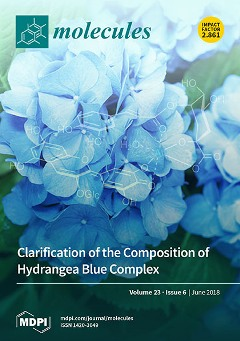Phyllodiumpulchellum has been traditionally used as a medicinal herb because of its health-promoting effects, such as its hepatoprotective and antioxidant activities. In the present study, the petroleum ether fraction, ethyl acetate fraction,
n-butanol fraction, and aqueous fraction were successively obtained from the ethanol extract of
P. pulchellum. Two fractions, ethyl acetate fraction and
n-butanol fraction, were found to display hepatoprotective and antioxidant activities. Further chemical investigation of the active fractions led to the isolation of its main constituents, including 11 flavonoids (
1–
11) and 8 indole alkaloids (
12–
19). There were 9 flavonoids (
1–
9) that were obtained from the ethyl acetate fraction, and 2 flavonoids (
10 and
11) and 8 alkaloids (
12–
19) from the
n-butanol fraction. Compounds
1–
11 and
16–
19 were isolated for the first time from
P. pulchellum, and
1,
2,
8,
11, and
18 were obtained from the genus
Phyllodium initially. Subsequently, the isolated compounds were evaluated for their in vitro hepatoprotective effects on the human normal hepatocyte cell line L-O2 injured by
d-galactosamine and radical scavenging activities against 1,1-diphenyl-2-picrylhydrazyl (DPPH). The flavonoids (−)-epigallocatechin (
5) and (−)-epicatechin (
6) exhibited prominent hepatoprotective activities with higher cell viability values (65.53% and 62.40% at 10 μM·mL
−1, respectively) than the positive control, silymarin (61.85% at 10 μM·mL
−1). In addition, compared with the positive control of vitamin C (IC
50: 5.14 μg·mL
−1), (−)-gallocatechin (
3) and (−)-epigallocatechin (
5) exhibited stronger antioxidant activities with IC
50 values of 3.80 and 3.97 μg·mL
−1, respectively. Furthermore, the total flavonoids from
P. pulchellum were characterized using a high-performance liquid chromatography-linear ion trap quadrupole-Orbitrap-mass spectrometry (HPLC-LTQ-Orbitrap-MS). In total, 34 flavonoids were tentatively identified, which had not been previously reported from
P. pulchellum. In addition, we performed a semi-quantitative analysis of the isolated flavonoids. The contents of compounds
1–
11 were 3.88, 17.73, 140.35, 41.93, 27.80, 4.34, 0.01, 0.20, 9.67, 795.85, and 5.23 μg·g
−1, respectively. In conclusion, this study revealed that the flavonoids that were isolated from
P. pulchellum showed hepatoprotective and antioxidant activities, indicating that, besides alkaloids, the flavonoids should be the potential pharmacodynamic ingredients that are responsible for the hepatoprotective and antioxidant activities of
P. pulchellum.
Full article






